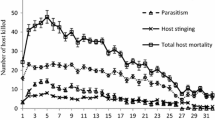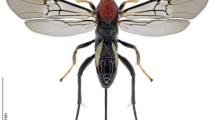Abstract
The rearing ofRaphitelus maculatus Walker, which oviposits through the bark onto beetle larvae has been carry out under standard laboratory conditions of 22 ± 2°C, 60% R.H. and photoperiod 16L∶8D. The host (Phloeotribus scarabaeoides Bernard) has been reared by cutting fresh branches of living olive tree on which they overwinter as adults. The effect of several rearing conditions (feeding conditions) on longevity and fecundity has been tested. The time of parasitoid and host development as well as the periods of emergence from the infested cut branches has been determined. It has been noted that both longevity and fecundity are influenced by the feeding conditions, reaching toca. double value when parasitoids were fully fed. Under standard rearing conditionsR. maculatus completes its life cycle in 17–18 days depending on sex, whereasP. scarabaeoides takes about 48 days. Finally 3 emergence periods has been observed from which the 1st is the most important and the 3rd is always the less significantly one, provided that the emerging brood cannot oviposits easier than the parents due to a decrease on host larvae proportion as well as on parasitoid fecundity.
Résumé
Raphitelus maculatus Walker est un parasitoide fréquemment associé au scolyte de l'olivier,Phloeotribus scarabaeoides Bernard, qui hiverne dans les branches de l'olivier (Olea europea L.). Dans les conditions contrôlées de laboratoire (22 ± 2°C, 60% H.R. et photopériode 16L∶8.0.),R. maculatus complète son cycle larvaire en 17 jours environ, tandisqueP. scarabaeoides effectue son développement en 48 jours.
On a étudié l'effet des conditions d'élevage sur la longévité des adultes et sur la fécondité des femelles et on a observé qu'elles sont très sensibles aux conditions alimentaires. La longévité varie selon la disponibilité en eau et en nourriture entre 2.65 et 14.95 jours chez les ♂♂, entre 5.04 et 15.57 jours chez les ♀♀.
La fécondité (nombre moyen d'œufs déposés) varie entre 18.2/♀♀ sans nourriture et 44.5/♀♀ alimentée.
Similar content being viewed by others
References
Arambourg, Y. — 1986. Traité d'entomologie oléicole. —Conseil Oléicole International. España, 360 pp.
Capek, M. — 1986. Lumcikovité[Hymenoptera: Braconidae] ako parasitoidy podkornych a drevokaznych skodcovduba — Vektorov tracheomykóz. —Biologia (Bratislava), 41, 535–542.
Dahlsten, D. L. & Dreistadt, S. H. — 1984. Forest insect pest management. —Bull. Entomol. Soc., 30, No 4.
Gonzalez, R. &Campos, M. — 1987. Contribución al estudio dePhloeotribus scarabaeoides (Bern.)[Coleoptera: Scolytidae] en madera de poda. —Fruticultura Profesional, 12, 118–120.
Kennedy, B. H. — 1970.Dendrosoter protuberans [Hymenoptera: Braconidae] and introduced larval parasite ofScolytus multistriatus. —Ann. Entomol. Soc. Am., 63, 351–358.
Maksimovic, M. — 1979. Influence of the density of bark beetle and their parasite on dieback of elm in some wood of Yugoslavia. —Z. Angew. Entomol., 88, 283–295.
Moek, H. A. & Safranyik, L. — 1984. Assessment of predator and parasitoid control of bark beetles. Environment. Canada. —Can. Forest. Ser. Pacific Forest Research Centre, BC-S-248, 24 pp.
Mendel, Z. — 1986. Hymenopterous parasitoids of bark beetles[Scolytidae] in Israel: Host relation, host plant, abundance and seasonal history. —Entomophaga, 31, 114–125.
Mendel, Z. — 1988. Effect of food, temperature and breeding conditions on the life span of adults of three cohabitating bark beetle[Scolytidae] parasitoids[Hymenoptera]. —Environ. Entomol., 17, 293–298.
Merlin, J. — 1984. Elm bark beetle and their main parasitoids in Belgium: Emergence and some aspects of their ecological relation. —Med. Fac. Landbouww. Rijksuniv., Gent, 49/3a, 857–866.
Pettersen, H. — 1976. Parasites[Hym.: Chalcidoidea] associated with bark beetles in Norway. —Norw. J. Entomol., 23, 75–78.
Russo, G. — 1938. Contributo alla conoscenza dei Coleotteri Scolitidi Fleotribi:Phloeotribus scarabaeoides (Bern.) Fauv. II. Biografia, simbionti, danni e lotta. —Boll. Lab. Entomol. Agric. Portici, 2, 3–420.
Author information
Authors and Affiliations
Rights and permissions
About this article
Cite this article
Campos, M., Gonzalez, R. Influence of breeding conditions on longevity and fecundity ofRaphitelus maculatus [Hym.: Pteromalidae] reared under standard laboratory conditions. Entomophaga 35, 411–420 (1990). https://doi.org/10.1007/BF02375265
Received:
Accepted:
Issue Date:
DOI: https://doi.org/10.1007/BF02375265




